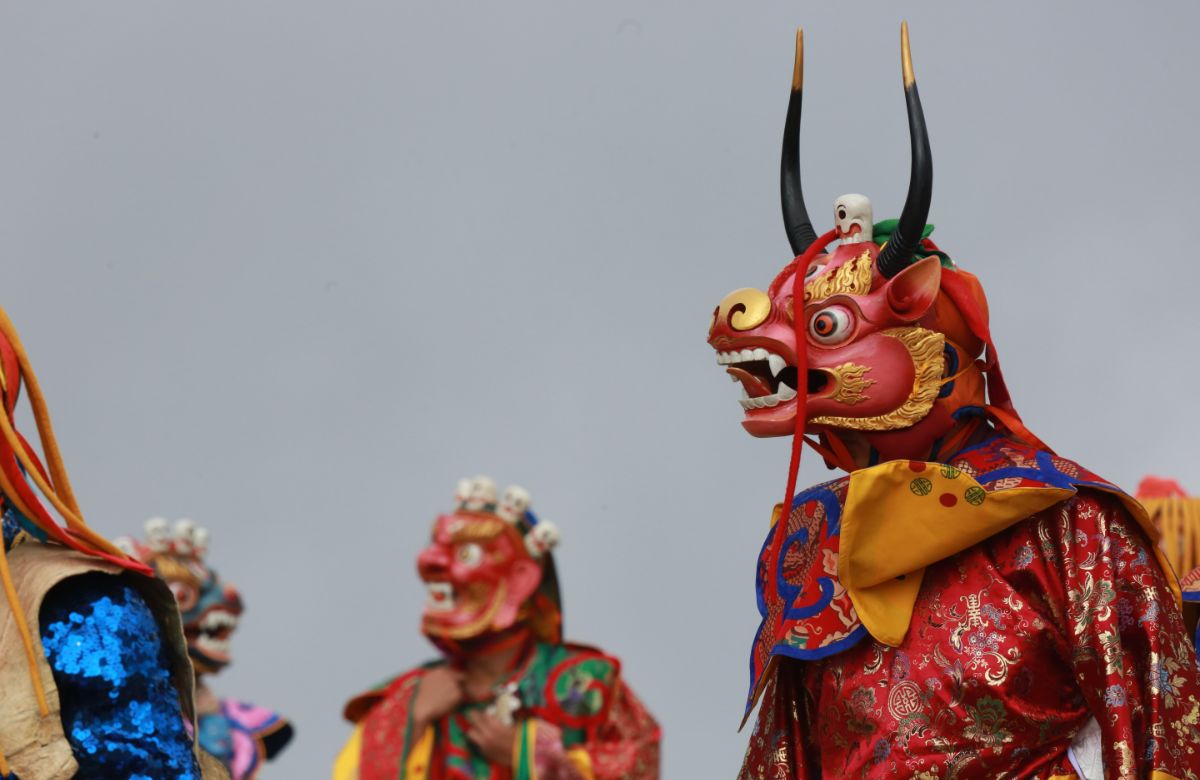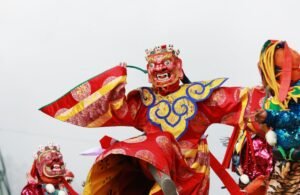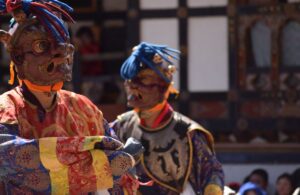Day 1: PARO (2250m) – THIMPHU (2300 m) 65KM/APPROX 1HR
Flying into Paro is one of the most spectacular flights one can experience. While descending into Paro valley, on a clear day sky you will be greeted by the world’s highest peaks, including Everest. The flight during late autumn is absolutely beautiful, though during the summers it will be cloudy. As the flight gets closer to the only international airport in Bhutan, you will see the Paro Dzong (fortress) on the hillside over looking Paro valley, with Ta Dzong, which now is the National Museum. Upon your arrival our representative will receive you and drive to Thimphu, The capital of Bhutan, The first stop will allow you to view the magnificent Tacho Lhakhang, The hereditary place of worship for Bhutan’s Iron Bridge Builder. After the visit we drive further to reach Chuzom, the confluence of Paro Chu (River) and Wang Chu (Thimphu Chu) After crossing Chuzom we enter Thimphu valley. In Thimphu we will stroll the market and mingle with local people. The Authentic Craft Market is place to visit, where you can find various Bhutanese handicrafts.
Overnight: Hotel/Resort in Thimphu
Day 2: THIMPHU (2300 m)
Today we begin our day by an early morning visit to the National memorial chorten. This is a Tibetan-style chorten built in 1974 in memory of the late King Jigme Dorji Wangchuk who passed away in 1972. It is one of the most visible religious structures in town and for many people it is the focus of daily worship. Remember to walk around the Chorten at least once to gain merit and good luck. We will take in more of kingdom’s rich culture at the Folk Heritage Museum. The museum is a restored three story traditional rammed mud and timber house inaugurated as a museum by Her Majesty the Queen Ashi Dorji Wangmo Wangchuk in 2001. It showcases the traditional artifacts used now and in the past, which helps connect people to the Bhutanese rural life.Next we will browse the striking collection of intricate textile at the National Textile museum.The Museum introduces you to the living national art of weaving. The exhibition displays the major weaving techniques and styles of local dress and textile made by the Bhutanese women and men. We will have time to quickly visit the Bhutanese Paper factory.The art of handmade paper in Bhutan dates back to the 8th century, although usage was limited mainly to religious purposes. Today it is considered an important element in the preservation of Bhutan’s cultural heritage. The factory allows guests to view the paper making process and purchase gifts from their show room.Towards evening we will visit Tashichhoe Dzong and have glimpse king Jigme’s Palace. The Dzong is popularly known as Thimphu Dzong or “the fortress of the glorious religion” it houses Bhutan’s administration, and the throne of His Majesty and other Government offices. It is also the summer residence of the Je Khenpo, the Chief Abbot of Bhutan. Just below the dzong we can have a glimpse of King’s palace.
Overnight: Hotel/Resort in Thimphu
Day 3: THIMPHU (2300 m)- Punakha (1310M) Approx 3hr drive 65 KM
Journey continues as we head towards Punakha at 1300 m and a warmer region. Punakha is the winter residence of the central monk body and it is one of the richest agricultural lands. The valley is blessed with one of the biggest rivers in the country. En-route we will cross over Dochula pass at 3050 meters, and view the most dramatic panoramic view of the greater Himalayas. During summers this mountain pass is covered with mists and the views are obstructed. The dochula landmark is the Wangyel Chortens – 108 stupas built on the mountaintop in a Mandala pattern, further enhances the beauty and tranquility of the pass. From this cooler mountain pass we will descend into a warmer region of Punakha. As we descend we will notice a change in vegetation and temperature too. On arrival, drive to Punakha Dzong, the “Palace of Great Happiness”
Built in 1637 by the Shabdrung, the ‘Unifier of Bhutan’, Punakha Dzong is situated at the confluence of the Mo Chu and Pho Chu (Mother and Father Rivers). It is the winter headquarters of the Je Khenpo and hundreds of monks who move en masse from Thimphu to this warmer location. The three story main temple of the Punakha Dzong is a breathtaking example of traditional architecture with four intricately embossed entrance pillars crafted from cypress and decorated in gold and silver. It was here in 1907 that Bhutan’s first king was crowned.
Overnight: Hotel/Resort in Punakha
Day 4: Punakha Festival with a Visit to the Devine Mad Man Temple “Chimi Lhakhang”
Enjoy a walk to Chimi Lhakhang, temple of the Drukpa Kuenly who is also known as the Divine Madman. He inherited the Divine Madman title since he revolted against the orthodox Buddhism in his time. He taught the people that religion is an inner feeling and it’s not necessary that one should be an ordained monk. He is also considered a symbol of fertility and most childless couples go to his temple for blessing. Afterwards, return to Punakha Dzong to observe the continuing masked dances and rituals that take place as part of the Punakha Festival.
Day 5: Punakha Festival and hike to Khamsum Yuelley Namgyal Chorten
After early breakfast we will travel up the valley north and cross the Mo Chhu to hike up and pay respect to the grand Khamsum Yuelley Namgyal Chorten, The Chorten is 30 meters (100 feet) tall and can be seen in the distance when driving. The three-levelled chorten took eight and a half years to build and was consecrated in 1999. Dedicated to the Fifth King, it was built to remove negative forces and to provide peace, stability, and harmony in an ever- changing world. It is therefore filled with every form of colorful protector imaginable. Heading back down the valley we will stop for lunch.After the lunch we will drive back to Punakha and interact with local people at the Festival.
Day 6: Punakha (1310M) – Phobjikha Valley (2900 m) 69KM/APPROX 3 ½HR (Day excursion)
Time to pack up and head to the colder valley of Phobjikha. The valley is significant in our country’s effort in preservation and protection the Black- Necked Cranes. Every year the birds arrive on their wintering grounds between mid-October and early December and remain until March through mid- April.We will visit the famous 16th century Gangtey Goemba that overlooks the large green expanse of the valley. The monastery is surrounded by a large village inhabited mainly be the families of the Gomchens (lay monk ) who take care of the monastery. After lunch we will walk downjill from the mani stone wall at Gangtey Goenpa to Khewa Lhakhang down in the valley. The trail is a gentle walk decending into the Semchubara village leading our way to a square Chorten and the Lhakhang. Then drive back to Punakha
Overnight: Hotel/Resort in Punakha
Day 7: Punakha (1310M) – PARO (2250 m) Approx 4hr drive 142 KM
The journey west takes us back to Paro valley following thru wang Chhu and Pa Chhu rivers. lunch at Paro.
PARO EXPERIENCES
Paro Cultural Tour should always start with a casual browse through the National Museum, housed in the Ta Dzong (Watch Tower) of the Rinpung Dzong. In the Museum the intriguing collection of artifacts serves as a great introduction to the rich culture and heritage of the Kingdom. The National Museum boasts a rich variety of exhibits collected from all over the country and belonging to different eras, some as early as 2000 B.C. A visit through the galleries shows the country”s transition from the later Stone Age to a modern Mahayana Buddhist kingdom.
We will then stroll down to the Paro Dzong and take in the amazing architecture of this 17th century monument, a premier example of Bhutan”s architecture. Paro Dzong, built in 17th century to defend Paro from the Tibetan invasion, is also known as Rinpung Dzong, which means the ‘fortress on a heap of jewels’. This fine example of Bhutanese architecture now serves as a central monastic and administrative seat of the Paro district. From the Dzong, a leisurely walk back into Paro town crosses the scenic Nyamai zampa, a unique model of Bhutan”s traditional cantilever bridge.
Overnight: Hotel/Resort in Paro
Day 8: PARO (2250 m) – Taktsang (Tiger’s nest monastery) 4-5 hrs hike
Today’s exploration of Paro valley begins with a hike to Taktsang (Tiger’s nest monastery) 4-5 hrs hike
Tiger”s Nest or Taktshang Goempa is one of Bhutan”s most revered monuments. It literally hangs off the face of a cliff 900 meters (2952 feet) above the valley floor. The legend states that Guru Rinpoche flew into
Bhutan on a mythical tigress and meditated in a cave before bringing Buddhism to Bhutan. The Taktshang Goempa is built around the cave, which is opened to the public once a year at the end of August. The four-hour round trip hike offers spectacular views of the Goempa and the valley below. Horses or mules can be arranged on request to help lighten the journey. After lunch drive up north to take a walk around the Drukgyel Dzong (ruins). The Dzong was built in 1649 to celebrate a decisive victory over Tibetan forces and to curtail further invasions. Under the leadership of Zhabdrung Ngawang Namgyal, the Bhutanese fought twelve battles with the Tibetans in different parts of the country, whereof one took place in Drukgyel Dzong. In the later years, the Dzong became an administrative centre under the Dzongpon (Lord of the Dzong) until gutted by a fire in 1951. Heading back down the valley we will stop at the auspicious kyichu Lhakhang. The 7th century monastery is one of the oldest and most sacred temples in the Kingdom where the seed of Buddhism was won in Bhutan. The Tibetan King, Songsten Gampo ordered the establishment of monasteries in the Himalayan region to subdue evil spirits and to spread Buddhism. Of the 108 monasteries, which were to be built, two major ones were built in Bhutan namely the Kyichu Lhakhang and the Jampa Lhakhang in Bumthang. Kyichu Lhakhang, which pins down the left foot of a treacherous Ogress, are a great finish to this day of cultural immersion and your journey to thisancient kingdom of Bhutan.
Overnight: Hotel/Resort in Paro
Day 9: DEPARTURE (Paro International Airport)



